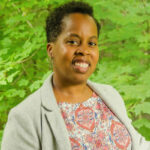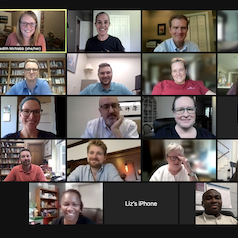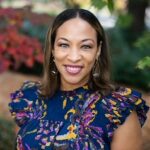Mapping the Landscape of Philanthropy and the Black Church
Mapping the Landscape of Philanthropy and the Black Church
by Jennifer Watley Maxell
How do Black church leaders see themselves on the landscape of philanthropy?
What organizations and people do these leaders turn to, from a place of trust, for support and capacity-building in ministry?
Over the past eighteen months, in partnership with Lake Institute, I have been exploring these crucial questions through conversations with a diverse group of Black church leaders across America. Whether on elevators, in conference rooms, over a meal, by phone or by Zoom, I have made a practice of asking my fellow Black ministry leaders how they think about philanthropy and how they relate to it. You can read and share my fuller exploratory report here. But, in brief, this is what I heard.
Finding Power, Stability, and Support in Networks
Like many institutions, the Black church is innovating and expanding in unique and exciting ways, even as traditional church attendance continues to decline. Therefore, as part of my exploration, I also conversed with social entrepreneurs, founders of new church plants, parachurch ministry leaders, and non-profit leaders. I found that many Black clergy straddle and blur vocational lines, creating broad vocational networks that coalesce around shared vision, passion, and purpose.
I heard an underlying perception that philanthropic organizations are only interested in funding large, established, institutionally supported ministries and projects. In other words, philanthropy is understood to be only interested in funding ministries and projects that already have money and well-established ties to an institution such as a seminary or denomination.
When I spoke with Black ministry founders, they mentioned support networks that did not include philanthropic institutions, such as crowdsourcing, venture capitalism, individuals with whom they have personal relationships, established churches/community organizations and collaboration with other ministries with similar vision. Among these ministry founders, there is power, stability and support in community, as they try to establish collaborative networks to share knowledge, relationships, and resources.
These founders conceded that Black churches have provided philanthropic support for them in the form of offerings/seed money, free office/event space, mentorship and access to the congregation or ministerial staff. However, they did not consider the Black church overall to be a philanthropic organization.
Not Even a Signpost, Much Less a Map
Among the pastors with whom I spoke were a dozen pastors who lead large urban or suburban megachurch congregations. When I told one pastor of a large, urban megachurch in Maryland that I was trying to map the landscape of the Black church and philanthropy, he quipped, “We don’t even have a signpost, not to mention a map.”
Some version of this sentiment was expressed repeatedly throughout these conversations. Philanthropy seems to be viewed as a niche funding source that is largely inaccessible to the Black church. The securing of a grant was seen as an anomaly.
Furthermore, none of the clergy identified or considered the Black church to be a philanthropic organization. Instead, they are viewed as either community service or charitable organizations. Many churches have established non-profit organizations (typically 501(c)(3)) or community development organizations, through which they meet various needs in their communities. However, instead of having trusted philanthropic partners with established relationships, these organizations tend to be formed and resourced on a case-by-case basis and are need-driven.
There seemed to be a perception that the identification of the Black church as a philanthropic organization could be a valuable designation with parishioners and funders, since the language of tithing, stewardship, etc. may be harder to explain or readily identify.
Of course, the flip side was also represented
The following question sums up the flip side. “Would identifying the Black church as a philanthropic organization inspire a false perception of the Black church as wealthy or flush with cash and property that might discourage continued support?”
Even in large megachurches with their own non-profit and community development entities, there is a perception that their grounding in faith and responsiveness to the community and the needs of their congregants requires a strong independence that must be protected and cannot ever be seen as commodified.
There is also a hesitation that, in these divisive times, the landscape and reality of challenging social injustice has become heightened and politicized, in a way that may set the Black church at odds with those who seek to fund their work. Many clergy expressed disinterest in attending meetings or conferences where the onus to prove “worthiness” is on the Black church, versus situations where all parties come together to learn, share, and connect with the expectation that partnership would form organically out of those relationships.
In summary, I see four areas for mutual work between philanthropic organizations and Black religious organizations.
Issues of knowledge
- The philanthropic world is a largely unknown and untapped area for most Black clergy.
- The philanthropic world doesn’t seem to understand the unique culture and contributions of the Black church.
Issues of language
- The philanthropic world has preferred terminology/insider language that isn’t known by most clergy.
- The philanthropic world doesn’t translate with the ways that clergy often view themselves and/or describe their work.
Issues of relationship
- Synergistic relationships must be built on trust, mutual respect, and common goals.
- Relationships should be responsive to a challenge and/or a need, as opposed to reactive.
Issues of self-identity
- Black clergy do not readily identify themselves or their congregations as philanthropists, nor do they see their contributions as philanthropic.
- Often their important contributions are identified as stewardship, worship, evangelism, discipleship, charity, etc.
When it comes to philanthropy, the Black church and Black clergy have much to offer and much to learn. The same can be said of philanthropic organizations. I am persuaded that the question isn’t so much how, but rather with whom. If relationships can be built on trust, and if mutual benefit for the common good can be established, I believe synergistic partnerships can be formed and necessary new work can begin.
Rev. Jennifer Watley Maxell is a published author, blogger and podcaster who received her Bachelor of Arts degree in Philosophy from Howard University, and her Master of Divinity degree from Emory’s Candler School of Theology. She founded “The Ellipsis Experience,” a nonprofit ministry for women and girls. She is an ordained Elder in the AME Church, and together with her husband, Rev. Charles A. Maxell, Jr., co-founded The Breakthrough Fellowship church in Cobb County, Georgia. Together they have three children.
Expanded Perspective: A Group Assignment
by Tasha Gisbon
 Part of what stood out to me in the exploratory report, authored by Rev. Jennifer Watley Maxell, is the idea that philanthropic institutions and Black religious organizations do not always know how to work together.
Part of what stood out to me in the exploratory report, authored by Rev. Jennifer Watley Maxell, is the idea that philanthropic institutions and Black religious organizations do not always know how to work together.
Working together is something that needs to be learned and practiced. Do you remember group projects in school? If a group is given an assignment and one person has an idea that they expect the rest of their group to do, the work may get done but not necessarily together. Or if a group doesn’t agree about what the assignment is, the work may not get done at all.
The same can happen when leaders of philanthropic institutions and Black religious organizations try to work together. As noted by Maxell, knowledge is key—and knowledge seems to be lacking. “The philanthropic world is an unknown and untapped area for most Black clergy,” she reports, adding “The philanthropic world doesn’t seem to understand the unique culture of the Black church.”
To work together well, it is crucial to know who is working together in the first place. This is particularly true when it comes to working together with Black religious organizations. Without that kind of awareness, the consequences that come from misunderstanding the assignment or not having what is necessary for the work could be detrimental to the people who will be impacted by the project. The particularity of that lack of knowledge between philanthropic institutions and Black religious organizations, which is part of what our Philanthropy and the Black Church work seeks to address, can be demonstrated in cases like movement capture during the U.S. civil rights movement and illustrated in data like results from a survey of U.S. nonprofit leaders.
A helpful place to start gaining clarity about who is working together, may be to understand, first, who the assignment is from, who the teacher is, if you will. I would argue the real assignment is not from funders, or from leaders of institutions and organizations. The real assignment is from the community. The community will evaluate the work. Working well together, informed by a community, could result in so much more than a good evaluation, a good grade. Working well together, as we get to know one another better, could result in something beyond what we could ever think or imagine.
Insights Audience Survey
 Your input is important to us at Lake Institute on Faith & Giving! If you’ve taken a course with us, you know we always conclude with an evaluation. We read those and use your feedback to improve our courses.
Your input is important to us at Lake Institute on Faith & Giving! If you’ve taken a course with us, you know we always conclude with an evaluation. We read those and use your feedback to improve our courses.
As recipients of Insights, your feedback matters to us. This is a short survey (and we mean it!) to understand what resources are valuable, plus a few questions about you (which are optional!).
We hope you will take a few minutes to respond to this survey and let us know how we can better serve you!
Spots Remaining for Spring Online ECRF
 Join us for the Spring online offering of the Executive Certificate in Religious Fundraising! In addition to weekly large group plenary and smaller peer group sessions, you have access to our online materials for a year, which includes videos from a variety of instructors and supplemental materials. There are still a few spots remaining. If you’ve been thinking about attending, now’s your chance!
Join us for the Spring online offering of the Executive Certificate in Religious Fundraising! In addition to weekly large group plenary and smaller peer group sessions, you have access to our online materials for a year, which includes videos from a variety of instructors and supplemental materials. There are still a few spots remaining. If you’ve been thinking about attending, now’s your chance!
Subscribe
Insights, a bi-weekly e-newsletter, is a resource for the religious community and fundraisers of faith-based organizations that provides:
- Reflections on important developments in the field of faith and giving
- Recommended books, studies and articles
- Upcoming Lake Institute events


